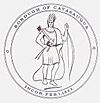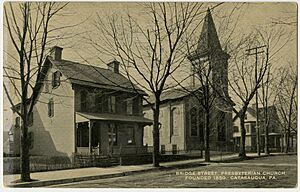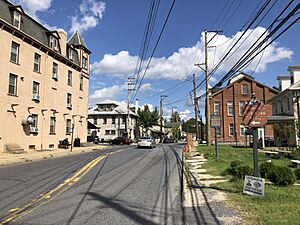Catasauqua, Pennsylvania facts for kids
Quick facts for kids
Catasauqua, Pennsylvania
|
||
|---|---|---|
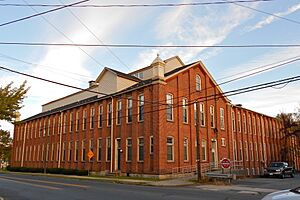
Dery Silk Mill in the Biery's Port Historic District of Catasauqua in October 2012
|
||
|
||
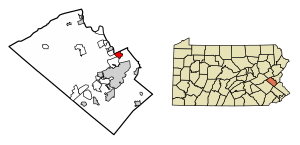
Location of Catasauqua in Lehigh County, Pennsylvania (left) and of Lehigh County in Pennsylvania (right)
|
||
| Country | ||
| State | ||
| County | Lehigh | |
| Area | ||
| • Borough | 1.33 sq mi (3.44 km2) | |
| • Land | 1.29 sq mi (3.35 km2) | |
| • Water | 0.04 sq mi (0.10 km2) | |
| Elevation | 279 ft (85 m) | |
| Population
(2020)
|
||
| • Borough | 6,518 | |
| • Density | 5,044.89/sq mi (1,948.11/km2) | |
| • Metro | 865,310 (US: 68th) | |
| Time zone | UTC-5 (EST) | |
| • Summer (DST) | UTC-4 (EDT) | |
| ZIP Code |
18032
|
|
| Area codes | 610 and 484 | |
| FIPS code | 42-11720 | |
| Primary airport | Lehigh Valley International Airport | |
| Major hospital | Lehigh Valley Hospital–Cedar Crest | |
| School district | Catasauqua Area | |
Catasauqua, often called Catty, is a small town in Lehigh County, Pennsylvania, United States. In 2020, about 6,518 people lived there. It's a suburb of Allentown in the Lehigh Valley. This larger area is home to over 860,000 people.
Catasauqua is famous for being the place where the first manufactured anthracite iron was made in the U.S. This happened in 1839. The town was first settled in 1805 and officially became a borough in 1853.
Contents
Where is Catasauqua?
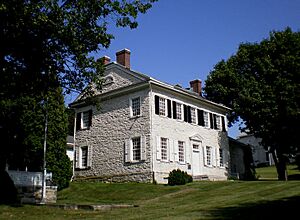
Catasauqua is located at 40°39′11″N 75°28′3″W / 40.65306°N 75.46750°W. It's about three miles (5 km) north of Allentown. The city of Bethlehem is about seven miles (11 km) to the east.
The town covers about 1.3 square miles (3.4 km2). Most of this area is land. A small part is water, including the Catasauqua Creek which flows through the town. The Lehigh River also runs along the southwestern edge of Catasauqua.
Nearby Towns and Areas
Catasauqua is surrounded by several other communities:
- Hanover Township
- North Catasauqua
- Whitehall Township
- Northampton
- Allentown
- Allen Township
- Bethlehem
- Coplay
- Hokendauqua
People in Catasauqua
| Historical population | |||
|---|---|---|---|
| Census | Pop. | %± | |
| 1860 | 1,932 | — | |
| 1870 | 2,853 | 47.7% | |
| 1880 | 3,065 | 7.4% | |
| 1890 | 3,704 | 20.8% | |
| 1900 | 3,963 | 7.0% | |
| 1910 | 5,250 | 32.5% | |
| 1920 | 4,714 | −10.2% | |
| 1930 | 4,851 | 2.9% | |
| 1940 | 4,764 | −1.8% | |
| 1950 | 4,923 | 3.3% | |
| 1960 | 5,062 | 2.8% | |
| 1970 | 5,702 | 12.6% | |
| 1980 | 6,711 | 17.7% | |
| 1990 | 6,662 | −0.7% | |
| 2000 | 6,588 | −1.1% | |
| 2010 | 6,436 | −2.3% | |
| 2020 | 6,518 | 1.3% | |
| Sources: | |||
In 2020, Catasauqua had a population of 6,518 people. The town has grown over the years. For example, in 1860, there were 1,932 residents. By 1900, the population was almost 4,000.
History of Catasauqua
The 18th Century
In 1768, George Taylor built a stone house in what is now Catasauqua. He was one of the Founding Fathers who signed the Declaration of Independence. His home, the George Taylor House, is now a National Historic Landmark. Back then, this area was known as Biery's Port.
The 19th Century: Industrial Growth
Catasauqua played a big part in the American Industrial Revolution. In 1840, the first successful use of anthracite iron in the U.S. happened here.
A man named David Thomas, who was from Wales, moved to the area. He started the Crane Iron Works. This company made iron using anthracite coal. A railroad, the Catasauqua and Fogelsville Railroad, was built to bring iron ore to the factory.
David Thomas is often called "the father of Catasauqua." He first named the community Craneville. He and his wife, Elizabeth, helped the town a lot. David Thomas started the Presbyterian Church, and Elizabeth gave money and land for the Welsh Congregational Church. Thomas also created the town's first fire company and its first public water system. He was even the town's first mayor, called a burgess.
In 1854, the town was officially named Catasauqua. This name comes from the Lenape language. It means "dry ground" or "thirsty ground." By 1900, Catasauqua had about 5,000 residents. It was known for having many self-made millionaires.
The 20th Century: "The Million Dollar Town"
During World War I (1914-1918), many young men from Catasauqua went to serve. In 1917, Catasauqua became the first town in the U.S. to raise $1 million for war bonds. This amazing effort earned it the nickname "The Million Dollar Town."
The 21st Century
In 2004, Catasauqua celebrated its 150th anniversary as an official borough. In 2014, the town also celebrated 100 years since its first "old home week" celebration. That first event in 1914 marked 75 years of the Lehigh Crane Iron Company.
Catasauqua has two special neighborhoods listed on the National Register of Historic Places. One is Biery's Port, located along the Lehigh River. The other is called "the mansion district." It has beautiful Victorian homes that belonged to wealthy residents long ago.
Schools in Catasauqua
Catasauqua is part of the Catasauqua Area School District. The district has three public schools:
- Sheckler Elementary (for grades K-4)
- Catasauqua Middle School (for grades 5-8)
- Catasauqua High School (for grades 9-12)
The school district also serves parts of Hanover Township and North Catasauqua.
Getting Around Catasauqua
In 2019, Catasauqua had over 20 miles (32 km) of public roads. Most of these roads are maintained by the borough itself. Some main roads that go through the town are Race Street, Lehigh Street, and Howerton Road.
Famous People from Catasauqua
Many notable people have come from Catasauqua, including:
- Buck Freeman – A professional baseball player for teams like the Boston Americans.
- Pat Kelly – A professional baseball player for the New York Yankees and other teams.
- Bert Kuczynski – Played both professional baseball (Philadelphia Athletics) and professional football (Detroit Lions, Philadelphia Eagles).
- Jonathan Linton – A professional football player for the Buffalo Bills.
- Thomas Lynch – A brave P-38 fighter pilot during World War II.
- Larry Miller – A professional basketball player for several teams.
- Anthony Recker – A professional baseball player for teams like the New York Mets.
Images for kids
See also
 In Spanish: Catasauqua para niños
In Spanish: Catasauqua para niños


